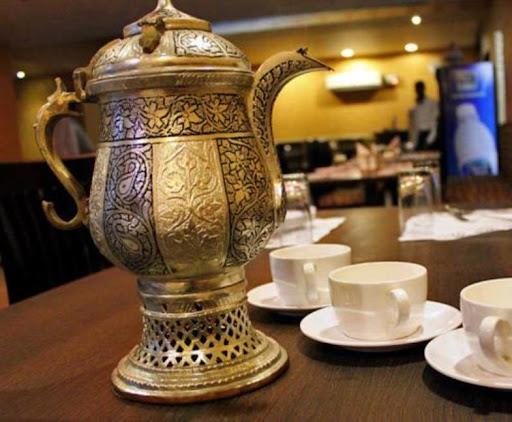(MENAFN- Kashmir Observer) Behind its revival is craft intervention. Photos Courtesy, Web Archives.
A traditional kettle used to brew, boil and serve tea and kehwa is making a creative comeback and dominating the market it lost to modern appliances and unsolicited health advices.
By Umar Hayat Hussain
IN the ongoing wedding season, Kashmir's iconic Zaina Kadal bazar is buzzing with shoppers swarming copper stores — show-piecing shimmering samovars in skilled shapes.
The craving for copper containers, especially the cultural kettle, is part of a wedding tradition in the valley.
“Among the copper vessels that bride takes to her in-laws as a gift for her new family members, designed Samovars are quite popular,” says Abdul Hameed, a coppersmith from Srinagar.
“These new-designed Samovars have their takers outside the valley as well. Away from their homeland, many Kashmiris order and showcase Samovar as a symbol of their culture.”

Designed Samovar has created its own market demand.
The revival of the ember-stoked vessel—a sign of Kashmir's Central Asian influence—in new designs is a recent craft intervention, mostly done in downtown's archetypal workplaces.
“This craft intervention is the part of our lineage,” says Rafiq Misgar, a coppersmith from Old Srinagar.“At the end of the day, craft is all about creating a market appetite.”
This creative appetite was created when the so-called modernism made morning teas devoid of samovar brew. All of a sudden, Rafiq says, some 'shady medicos' started terming the Samovar tea as a 'detrimental drink' for health.
“It was a big concern for coppersmiths and our existence,” Rafiq continues.“The so-called unsolicited medical advice spread like a wildfire through word of mouth and threatened to create a cultural demise in Kashmir.”
Such notions were seen as an assault on the craftsmen community sustaining the valley from ages, Rafiq says.
“So we had plastic-made flasks as our morning tea-containers now,” he says.“But no unsolicited medical advice was given, when it was a clear harmful morning shift in our lives.”
Amid this concern, the coppersmith says, his clan had to do something about the craft demise and they did it by making new patterns.
In his early thirties, Rafiq reckons that the creative designs eventually revived the copper market in Kashmir.
“There was a time in recent past when hardly anyone was considering a copper container in Kashmir,” he says.“Even the tradition of giving copper vessels to brides was considered an obsolete practice. But now, thanks to new designs, Samovar has once again graced Kashmiri homes.”
While 'wouste' Rafiq gives final touches to Samovar, his apprentice engraves bottom shelf of utensil and attaches chimney to give it a proper shape of kettle.
Rafiq engraves Chinar leaf on Samovar to add“beauty, style and elegance to it”.
Kashmir-event.-scaled.jpg?w=2560 & ssl=1 2560w, -a- Kashmir-event.-scaled.jpg?resize=300%2C225 & ssl=1 300w, -a- Kashmir-event.-scaled.jpg?resize=1024%2C768 & ssl=1 1024w, -a- Kashmir-event.-scaled.jpg?resize=768%2C576 & ssl=1 768w, -a- Kashmir-event.-scaled.jpg?resize=1536%2C1152 & ssl=1 1536w, -a- Kashmir-event.-scaled.jpg?resize=2048%2C1536 & ssl=1 2048w, -a- Kashmir-event.-scaled.jpg?resize=795%2C596 & ssl=1 795w, -a- Kashmir-event.-scaled.jpg?resize=1168%2C876 & ssl=1 1168w, -a- Kashmir-event.-scaled.jpg?resize=320%2C240 & ssl=1 320w" sizes="(max-width: 1000px) 100vw, 1000px" data-recalc-dims="1" />
A Samovar tea served in a Kashmir event.
Depending on the size and decoration, says Sajad Khan, another coppersmith from downtown, a Samovar costs anything between Rs 5000 to Rs 30000.
“Samovar making usually takes three to seven days, depending on its size and design,” Sajad says.“And then it also depends on the demand which is quite good now.”
Interestingly, the old brew is back when power kettles and flasks have almost made Samovar an obscure cultural object.
“Samovar is the ultimate gift for any occasion,” Sajad says.“It's being praised by all and sundry—especially sightseers who quietly arrive in the valley to learn from our culture and tradition.”
| Be Part of Quality Journalism |
| |
| Quality journalism takes a lot of time, money and hard work to produce and despite all the hardships we still do it. Our reporters and editors are working overtime in Kashmir and beyond to cover what you care about, break big stories, and expose injustices that can change lives. Today more people are reading Kashmir Observer than ever, but only a handful are paying while advertising revenues are falling fast. |
| ACT NOW |
| MONTHLY | Rs 100 |

|
| | | |
| YEARLY | Rs 1000 |

|
| | | |
| LIFETIME | Rs 10000 | |
| | | |
MENAFN31072021000215011059ID1102548559
Legal Disclaimer:
MENAFN provides the information “as is” without warranty of any kind. We do not accept any responsibility or liability for the accuracy, content, images, videos, licenses, completeness, legality, or reliability of the information contained in this article. If you have any complaints or copyright issues related to this article, kindly contact the provider above.